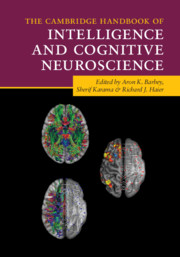Book contents
- The Cambridge Handbook of Intelligence and Cognitive Neuroscience
- Reviews
- The Cambridge Handbook of Intelligence and Cognitive Neuroscience
- Copyright page
- Dedication
- Contents
- Figures
- Tables
- Contributors
- Preface
- Part I Fundamental Issues
- Part II Theories, Models, and Hypotheses
- Part III Neuroimaging Methods and Findings
- Part IV Predictive Modeling Approaches
- Part V Translating Research on the Neuroscience of Intelligence into Action
- 18 Enhancing Cognition
- 19 Patient-Based Approaches to Understanding Intelligence and Problem-Solving
- 20 Implications of Biological Research on Intelligence for Education and Public Policy
- 21 Vertical and Horizontal Levels of Analysis in the Study of Human Intelligence
- 22 How Intelligence Research Can Inform Education and Public Policy
- 23 The Neural Representation of Concrete and Abstract Concepts
- Index
- References
19 - Patient-Based Approaches to Understanding Intelligence and Problem-Solving
from Part V - Translating Research on the Neuroscience of Intelligence into Action
Published online by Cambridge University Press: 11 June 2021
- The Cambridge Handbook of Intelligence and Cognitive Neuroscience
- Reviews
- The Cambridge Handbook of Intelligence and Cognitive Neuroscience
- Copyright page
- Dedication
- Contents
- Figures
- Tables
- Contributors
- Preface
- Part I Fundamental Issues
- Part II Theories, Models, and Hypotheses
- Part III Neuroimaging Methods and Findings
- Part IV Predictive Modeling Approaches
- Part V Translating Research on the Neuroscience of Intelligence into Action
- 18 Enhancing Cognition
- 19 Patient-Based Approaches to Understanding Intelligence and Problem-Solving
- 20 Implications of Biological Research on Intelligence for Education and Public Policy
- 21 Vertical and Horizontal Levels of Analysis in the Study of Human Intelligence
- 22 How Intelligence Research Can Inform Education and Public Policy
- 23 The Neural Representation of Concrete and Abstract Concepts
- Index
- References
Summary
One of the major achievements of psychology in the twentieth century is the establishment and implementation of standard measures of human intelligence. The use of these measures yielded a large body of research as well as many controversies and criticisms (for review see Nisbett et al., 2012). The relatively recent development of structural and functional brain imaging techniques led to attempts to identify the neural correlates of intelligence, as well as to the use of intelligence testing as a diagnostic and prognostic factor within clinical populations. Different syndromes are characterized by a unique pattern of performance on standard intelligence tests, with specific profiles reported for patients with developmental disorders (e.g., Down syndrome, autism spectrum disorder), for neurological and neurodegenerative disorders (e.g., epilepsy, multiple sclerosis, Parkinson’s disease, Alzheimer’s disease), and for acute neurological trauma (e.g., traumatic brain injury and stroke. See Hamburg et al., 2019; Wechsler, 2008a). In this chapter, we will highlight the clinical implications of studying intelligence in adults with traumatic brain injury (TBI), which has been a central research interest for our group over the years. When appropriate, we will also provide additional examples referring to other clinical populations.
- Type
- Chapter
- Information
- Publisher: Cambridge University PressPrint publication year: 2021



